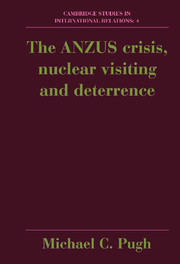Book contents
- Frontmatter
- Contents
- List of tables
- Preface
- List of abbreviations
- 1 INTRODUCTION: THE REVOLT OF AN UNDERLING
- 2 THE ANZUS TREATY AND STRATEGIC DEVELOPMENTS
- 3 DEFENCE CO-OPERATION AND NUCLEAR CONNECTIONS
- 4 WARSHIP ACCESS AND THE ANZAC LIABILITY SUSPENSIONS
- 5 NUCLEAR HAZARDS AND ENVIRONMENTAL SAFETY: ISSUES OF THE 1980S
- 6 ANTI-NUCLEAR POLITICS
- 7 FROM NEGOTIATION TO LEGISLATION
- 8 REGIONAL SECURITY AND THE FUTURE OF ANZUS
- 9 THE ANZUS CRISIS, NUCLEAR VISITING AND THE WESTERN ALLIANCE
- APPENDICES
- Notes
- Bibliography
- Index
4 - WARSHIP ACCESS AND THE ANZAC LIABILITY SUSPENSIONS
Published online by Cambridge University Press: 06 July 2010
- Frontmatter
- Contents
- List of tables
- Preface
- List of abbreviations
- 1 INTRODUCTION: THE REVOLT OF AN UNDERLING
- 2 THE ANZUS TREATY AND STRATEGIC DEVELOPMENTS
- 3 DEFENCE CO-OPERATION AND NUCLEAR CONNECTIONS
- 4 WARSHIP ACCESS AND THE ANZAC LIABILITY SUSPENSIONS
- 5 NUCLEAR HAZARDS AND ENVIRONMENTAL SAFETY: ISSUES OF THE 1980S
- 6 ANTI-NUCLEAR POLITICS
- 7 FROM NEGOTIATION TO LEGISLATION
- 8 REGIONAL SECURITY AND THE FUTURE OF ANZUS
- 9 THE ANZUS CRISIS, NUCLEAR VISITING AND THE WESTERN ALLIANCE
- APPENDICES
- Notes
- Bibliography
- Index
Summary
The ANZUS crisis was a political dispute over military co-operation and the next two chapters refer to principles which affect the particular form of co-operation and their specific application to Australia and New Zealand. Although the basing and visiting of aircraft caused controversy in relation to the staging of B-52s at Darwin and USAF shuttles to Christchurch, this discussion focusses on the rather more critical factors affecting warship access. In particular, as NCND is one of the conditions which nuclear navies insist upon when in foreign ports, the origins of and explanations for it will be considered here. Non-disclosure was to prove the stumbling block in New Zealand's bid to gain US and British acceptance that its ports and internal waters would be genuinely nuclear free.
The chapter then addresses the issue of port access for nuclear propelled vessels which was disrupted in the 1960s and 1970s by problems over legal liability for accidents. The ‘liability suspensions’ operated by Australia and New Zealand had a lasting significance in the evolution of visit policy and the elaboration of ANZUS alliance requirements. Lifting the suspensions also added to the debate, discussed in chapter 5, about visit management and provision for dealing with nuclear hazards. To begin with, however, it is worth stressing that countries often restrict access by foreign warships to areas over which they can exercise control.
- Type
- Chapter
- Information
- The ANZUS Crisis, Nuclear Visiting and Deterrence , pp. 61 - 81Publisher: Cambridge University PressPrint publication year: 1989

